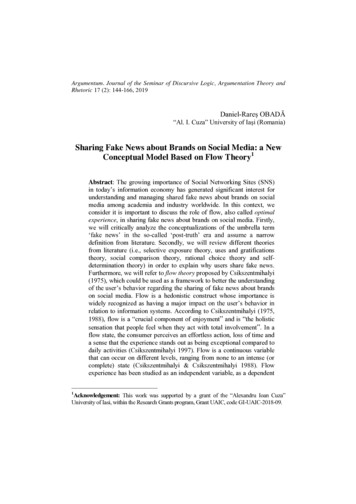
Transcription
Argumentum. Journal of the Seminar of Discursive Logic, Argumentation Theory andRhetoric 17 (2): 144-166, 2019Daniel-Rareș OBADĂ“Al. I. Cuza” University of Iaşi (Romania)Sharing Fake News about Brands on Social Media: a NewConceptual Model Based on Flow Theory1Abstract: The growing importance of Social Networking Sites (SNS)in today‟s information economy has generated significant interest forunderstanding and managing shared fake news about brands on socialmedia among academia and industry worldwide. In this context, weconsider it is important to discuss the role of flow, also called optimalexperience, in sharing fake news about brands on social media. Firstly,we will critically analyze the conceptualizations of the umbrella term„fake news‟ in the so-called „post-truth‟ era and assume a narrowdefinition from literature. Secondly, we will review different theoriesfrom literature (i.e., selective exposure theory, uses and gratificationstheory, social comparison theory, rational choice theory and selfdetermination theory) in order to explain why users share fake news.Furthermore, we will refer to flow theory proposed by Csikszentmihalyi(1975), which could be used as a framework to better the understandingof the user‟s behavior regarding the sharing of fake news about brandson social media. Flow is a hedonistic construct whose importance iswidely recognized as having a major impact on the user‟s behavior inrelation to information systems. According to Csikszentmihalyi (1975,1988), flow is a “crucial component of enjoyment” and is “the holisticsensation that people feel when they act with total involvement ”. In aflow state, the consumer perceives an effortless action, loss of time anda sense that the experience stands out as being exceptional compared todaily activities (Csikszentmihalyi 1997). Flow is a continuous variablethat can occur on different levels, ranging from none to an intense (orcomplete) state (Csikszentmihalyi & Csikszentmihalyi 1988). Flowexperience has been studied as an independent variable, as a dependent1Acknowledgement: This work was supported by a grant of the “Alexandru Ioan Cuza”University of Iasi, within the Research Grants program, Grant UAIC, code GI-UAIC-2018-09.
Sharing Fake News about Brands in Social Media: a New Conceptual Model 145variable, and lately, as a mediator variable. In this paper we propose anew conceptual model containing 3 variables: (1) fake news spreadabout brands in SNS, (2) flow state experienced by SNS human users(i.e., optimal experience), and (3) sharing fake news about brands onsocial media by SNS human users (i.e., social media behavior). Weconclude by outlining the need to empirically test the new conceptualmodel proposed in this paper.Keywords: fake news, conceptual model, flow theory, social media,brand1. IntroductionIn the last years, the number of Internet users has increasedexponentially, reaching up to 4,383,810,342 users in March 2019, with apenetration rate of 56.8 % in World Population.2 The number of socialmedia users was around 3.484 billion in January 2019, with a penetrationrate of 45% in World Population.3 In this context, the growing importanceof Social Networking Sites (SNS) in today‟s information economycreated a significant interest among academia and industry worldwide formanaging online brand communication. The growth of SNS changed theway people communicate with each other because it became the majorplatform for online social interaction and information transmission (Shu,Sliva, Wang, Tang & Liu 2017). Moreover, due to several maincharacteristics of social media networks, such as: ease-of-use, low cost,rapid rate, and immediate feedback, a large amount of information isbeing produced, commented and shared online by users. Thus, it becomesextremely difficult for communication practitioners to manage brandcommunication in the online environment.Online social media is changing the way in which we consumenews and information because online users can not only learn about thetrending events, but they can also share their stories and advocate fordifferent problems and issues (Shu et al. 2017). The Pew Research Centerreported in 2017 that 66% of U.S. adults used Facebook and 45% of themgot their news from this social media platform. YouTube had a base of2Source: Internet World Stats. Report published online: “Internet Usage and WorldPopulation Statistics estimates for March 31, 2019”. Accessed May 5th, 3Source: DataReportal. Report published online: “Digital 2019: Global Digital Overview”.Accessed May 5th, 2019. al-digital-overview.
146Daniel-Rareș OBADĂ58% of the American population out of which 18% read news onYouTube, making it the second most common social media site for news.Twitter is also a pathway to news used by Americans: 15% of U.S. adultsuse it and 11% get their news from it. Other social media sites, such asInstagram (26% of U.S. adults users; 7% get news from it), LinkedIn(21% of U.S. adults users; 5% read news on it), Snapchat (18% of U.S.adults users; 5% get news from it), WhatsAPP (11% of U.S. adults users;2% read news on it), Reddit (6% of U.S. adults users; 4% get news fromit) and Tumblr (4% of U.S. adults users; 1% read news on it) are alsosources of getting the news.4 Considering this data, we could argue thatsocial media sites are important communication channels that need to beconsidered by marketing specialists in managing online brandcommunication.The amount and richness of information available on social mediahas facilitated the manner in which people communicate with each otherand offered important opportunities, but it has also challenged thecommunication specialists. Not only that customers can stay informed byusing social media, but they can also share experiences and interact withincertain social groups, influence their friends and followers cognitions,attitudes and behaviors regarding brands. In this context, brands can losecontrol over their communication strategy (Allcott & Gentzkow 2017;Fulgoni & Lipsman 2017) and information accuracy becomes essential.Furthermore, more recent information spread on social media as news isdubious and, in some cases, intended to mislead - such content is oftencalled fake news (Zhang & Ghorbani 2019). After the 2016 U.S.presidential election campaign, believed to be influenced by fake news,scholars and communication practitioners seeked to understand the fakenews phenomenon (Zhang & Ghorbani 2019). Studies emerging fromdifferent fields, such as political communication, library sciences,journalism, psychology, philosophy, information sciences and businesscommunication focused on fake news origins, distribution and effects.In this paper, we discuss the problem of fake news phenomenon inthe brand communication context because social media emerged as theprimary source of information for many customers. Since the 2016 USelections, there has been a surge of fake news. Not only politicalcandidates and news organizations are fake news targets, but also brandssuch as Starbucks, Microsoft, Pepsi and New Balance have become4Source: Pew Research Center. Report published online: “News Use Across Social MediaPlatforms 2017”. Accessed May 19th, 2019. ss-social-media-platforms-2017/.
Sharing Fake News about Brands in Social Media: a New Conceptual Model 147victims of it.5 Fake news outperformed real news in terms of popularity andengagement on social media (Price 2017), and it became crucial forcompanies to understand how this proliferation may harm their marketingefforts (YouGov 2017). Moreover, fake news can have negativeconsequences for a brand: the loss or damage of reputation can affect abrand‟s competitiveness, trust and loyalty (Aula 2010). Fake news can hurtbusinesses financially and it can also make things toxic for them bydestroying trust and creating an atmosphere in which people do not knowwho to trust6.Fake news can spread rapidly on social media and may be used bymalicious entities or competitors to manipulate the customer‟s options anddecisions, like stock markets or online shopping. The key aspect in fakenews proliferation is the content diffusion (i.e., the complex contagion) inthe online environment. Although in literature scholars proposed differenttheories in order to explain fake news diffusion on social media, there isstill a lack of understanding regarding the spreading mechanisms. In thispaper we propose a new conceptual model of fake news spreading on socialmedia, using flow theory as a theoretical framework.2. Fake News Literature ReviewIn this section we critically review the state of art regarding thefake news phenomenon. We consider it important to refer to fake news‟historical evolution and definitions, the relationship between brands andfake news, fake news creators, and fake news spreaders on social media.2.1. Historical Evolution of Fake NewsFake news is not a new phenomenon (Gelfert 2018; McGonagle2017) because the partisan press has always peddled biased opinions andstories lacking factual basis (McGonagle 2017). New technologies, fromthe telegraph in the 19th century to contemporary social media algorithms,have lead to fake news proliferation (Gelfert 2018). For example, Gelfert(2018) refers to an article written by J. B. Montgomery-McGovern in1898, in the Arena journal, entitled “An important phase of gutterjournalism: Faking”, in order to outline the challenges of fake news in the5Kuchler, H. “Companies Scramble to Combat Fake News”. Financial Times, 22 August2017. Accessed May 19th, 2019. c5b903247afd.6Ibidem.
148Daniel-Rareș OBADĂ19th century. In his article, Montgomery-McGovern (1898) complainsabout “fake journalism”, considered to be “the most sensational stories”published by news organizations (1898, 240) and explains the “stand-for”technique used by “fakers” to deceive: they used a reputable member ofthe community (e.g., a doctor, dentist, architect, or other professional orbusiness man) who, for money, would corroborate the fake story.Gelfert (2018) considers nowadays fake news creators eliminatedthe “middle-men” and address the readers directly, by sharing thesensational stories on social media. Figueira & Oliveira (2017) argue thatfake news (i.e., inaccurate, false, or grossly distorted informationpresented as news in order to deceive the audience) are produced anddisseminated on an exponential online scale causing a real impact onbrands. In addition, another important aspect to take into accountregarding fake news proliferation is the post-truth era.Fake News in the Post-Truth EraAlthough fake news is not new, the scale of the problem has grownexponentially in the last years and it should be analyzed in the post-truthera context. The term “post-truth” was first used in 1992 by Tesich todescribe a mostly political environment in which debate is framed byappealing to emotion, with repeated assertions of half-truths and outrightlies whose factual re-buttals are ignored. Since 1992, scholars have arguedthat we are living in the post-truth era, in which: (1) emotions and personalbeliefs are more important than facts, (2) the truth of the story no longermatters, (3) there is a mistrust in authority, and (4) an appeal to negativeemotions, such as fear or anxieties (Laybats & Tredinnick 2016).Rochlin (2017) argues that in the post-truth era facts and evidencehave been replaced with personal belief and emotion. “Fake news” nolonger stand for factless or slanderous news, but rather news that areconsidered to attack a person‟s pre-existing beliefs (Rochlin, 2017). A keyaspect to take into consideration is the nature of the news and what peopleaccept as news rather than facts (Rochlin 2017). Rochlin (2017) arguesthat nowadays the society has shifted towards a belief and emotion-basedmarket. In this context, from a marketing communication perspective,brands can thrive in an emotionally based market, but can also be affectedby fake news. Fake news stories that spread via social media intertwinewith journalism and become primary sources of information because theyare considered by people to be real news (Rochlin 2017).
Sharing Fake News about Brands in Social Media: a New Conceptual Model 1492.2. Fake News ConceptualizationsA critical literature review regarding fake news conceptualizationreveals a broad range of definitions proposed by different scholars andpractitioners. For example, Lazer et al. (2018, 1094) conceptualize fakenews as “news stories that were fabricated, but presented as if fromlegitimate sources, and promoted on social media to deceive the public forideological and/or financial gain”. Zhang & Ghorbani (2019) considerfake news to encompass all kinds of false stories or news that are mainlypublished and distributed on the Internet, in order to purposely mislead,befool or lure readers for financial, political or other gains. Oremus(2017) defines fake news as information that is designed to be confusedwith legitimate news, and is intentionally false. Levy (2017, 20) arguesthat “fake news is the presentation of false claims that purport to be aboutthe world in a format and with a content that resembles the format andcontent of legitimate media organizations”. Furthermore, Rini (2017, 45)states that “a fake news story is one that purports to describe events in thereal world, typically by mimicking the conventions of traditional mediareportage, yet is known by its creators to be significantly false, and istransmitted with the two goals of being widely re-transmitted and ofdeceiving at least some of its audience.”According to Visentin, Pizzi & Pichierri (2019) a good definitionof fake news should incorporate the fact that they are intentionally falseand fabricated stories (Allcott & Gentzkow 2017; Lazer et al., 2018), yetperceivably realistic (i.e., consistent with an individual‟s previous beliefs)(Fulgoni & Lipsman 2017, 100).Martens, Aguiar, Gomez-Herrera & Mueller-Langer (2018)explain that there is no consensus in the literature on fake newsconceptualizations. The fake news definitions emphasize four dimensionsof the construct: (1) type of information, (2) falsity of information, (3)intention of the author, and (4) consequences of the informationdissemination, including personal (perception of the receiver) and societaleffects (disruption of democratic processes). The first two dimensions(i.e., type and falsity of information) narrow fake news definitions andtend to focus on verifiably false news reports, whereas broader definitionsinclude any misleading or distorted information. The last two dimensions(i.e., intention of the author and consequences of the informationdissemination) better reflect the reality of manipulative stories – many ofwhich are not entirely false, but, at the same time, mix deliberatefalsehoods with well-known truths by selectively presenting partial truths,
150Daniel-Rareș OBADĂemploying a false context or manipulating images alongside verified newsstories (Martens et al. 2018).The EU High Level Expert Group (Martens et al. 2018) agreedthat when defining fake news, we only have two options: to assume eithera broader or a narrow definition of fake news. Martens et al. (2018, 9)propose a broader definition of fake news: “as disinformation thatincludes all forms of false, inaccurate or misleading information designed,presented and promoted to intentionally cause public harm or for profit(e.g., commercial click-bait)”. This broader definition of fake newsencompasses deliberate attempts at disinformation and distortion of news(Martens et al. 2018; Wardle & Derakhshan 2017; Gelfert 2018), the useof filtered versions to promote ideologies, confuse, sow discontent andcreate polarization (Martens et al. 2018). Martens et al. (2018) argue thata broader definition of fake news is more difficult to verify objectively, butcould be useful in research fields that study the structure of news markets,compare pre-digital offline news with digital online news markets and tryto assess the impact of digitization on the quality of news production andconsumption.A narrow definition of fake news proposed by Alcott & Gentzkow(2017, 213) conceptualizes fake news as “intentionally and verifiablywrong or false news produced for the purpose of earning money and/orpromoting ideologies”. They consider fake news to be “news articles thatare intentionally and verifiably false, and could mislead readers” (Allcott& Gentzkow 2017, 213). Allcott & Gentzkow (2017) explain that there isa market for verifiably false news because: (1) it is cheaper to produce falsethan to generate accurate news, (2) it is costly for consumers to distinguishbetween accurate and fake news, and (3) consumers may enjoy readingfake news because it confirms their beliefs. Gelfert (2018) considers thatthe fake news term should be reserved for cases of deliberate presentationof typically false or misleading claims as news, where these are misleadingby design, (.) systemic features of the sources and channels by which fakenews propagates and thereby manipulates (.) consumers’ pre-existingcognitive biases and heuristics.Martens et al. (2018) argue that a narrow definition of fake newswould be limited to verifiably false information. In this case, fact checkingcan expose false news items and identify the sources of these articles. Thisnarrow definition requires an identifiable and well-defined set of false newsarticles and sources to measure the reach and impact of false news (Martenset al. 2018; Alcott & Gentzkow 2017; Fletcher et al. 2018). The EU HighLevel Expert Group consider the narrow definition of fake news to be more
Sharing Fake News about Brands in Social Media: a New Conceptual Model 151appropriate for empirical studies conducted in the consumer behavior field(Martens et al. 2018). Thus, in this paper we assume the narrow definitionof fake news from literature because we consider it to be more appropriatefor our research project. In a future study, we intend to empirically test theconceptual model proposed in this paper.2.3. Brands and Fake NewsThe relationship between brands and fake news is complicated.Berthon, Treen & Pitt (2018) explain that brands can interact both directlyand indirectly with fake news. First of all, brands can interact directlywith fake news by becoming victims or purveyors (Berthon et al. 2018).Secondly, brands can interact indirectly with fake news because they canbe linked via image transfer to either where fake news contaminatesbrands, or brands validate fake news (Berthon et al. 2018). Although therelationship between brands and fake news is complex, in this paper weare interested in understanding the mechanism of fake news spreading, inwhich brands are victims and not sources. In this section we will brieflypresent three case studies of brands affected by fake news shared onsocial media.Brands as Victims of Fake News: The Pepsi Co, New Balanceand Starbucks casesIn some cases, brands can be fake news casualties (Berthon et al.2018) and financially affected by rapidly spread fake news on socialmedia. Pepsi Co stock fell around 4% just prior to the 2016 USpresidential election when a fake news story about Pepsi’s CEO, IndraNooyi, telling Trump supporters to “take their business elsewhere”spread in social media.“In an interview at the New York Times Dealbook Conference, PepsiCoCEO Indra Nooyi said, „I think we should mourn for those of us whosupported the other side‟. But she also added, „we have to come togetherand life has to go on‟ and even congratulated Trump on his victory. Butthe Conservative Treehouse blog falsely quoted Nooyi with thesensationalist headline: „Massive Stewardship Fail – PepsiCo CEO TellsTrump Supporters to Take Their Business Elsewhere.‟ Fake new sites
152Daniel-Rareș OBADĂjumped on the fictitious quote, with people threatening to boycott all ofPepsi‟s brands using the hashtags #boycottPepsi and #Pepsiboycott.”7Figure 1: Fake news spread on Twitter about Pepsi Co CEO Indra Nooyistatement8Figure 1 depicts the fake news shared on Twitter about Pepsi CoCEO Indra Nooyi statement. Analyzing the image we notice themisleading headline, the picture of Pepsi Co CEO Indra Nooyi and thehashtag #PepsiBoycott. This fake news spread on social media aboutPepsi Co brand had a negative financial impact: the stock fell around 4%.The Pepsi Co fake news case shows how top brands can be the target offake news spread on social media. In this context, from a marketingcommunication perspective, understanding the mechanism of fake newsspreading seems to be extremely important.Another brand affected by fake news spread on social media isNew Balance. A fake news spreader misquoted the New Balance7Source: Plusar. Accessed May 19th, 2019. mage source: Twitter
Sharing Fake News about Brands in Social Media: a New Conceptual Model 153spokesman and repackaged the message with the headline “New Balanceoffers a wholesale endorsement of the Trump revolution”. Here is the fullcontext:“In the wake of the deeply divisive US presidential elections, brands werewise to keep out. But New Balance was accidentally drawn in. AntiTrump websites misquoted a New Balance spokesperson saying Obamahad let them down and with Trump „things are going to move in the rightdirection‟. While the spokesperson was referring to the Trans-PacificPartnership only, the internet seized the quote and repackaged themessage: New Balance offers a wholesale endorsement of the Trumprevolution. It led to alt-right groups praising it as a brand for whiteAmericans, while anti-Trump groups burning their New Balance shoesand sharing the ritual online.” 9Figure 2: Image posted online with New Balance shoes thrown to garbage byanti-Trump customersThis fake news was shared in social media and caused negativereaction (see Figure 2): anti-Trump groups burned their shoes andbroadcasted online because New Balance was declared “the official shoes9Source: Plusar. Accessed May 19th, 2019. pepsi-new-balance-and-facebook-battle-fake-news.
154Daniel-Rareș OBADĂof white people”. The New Balance case can be useful to betterunderstand the negative consequences of fake news on brand image.Starbucks was also a target of fake news spread on social media.In this case, in 2017, a hoax affected Starbucks‟ reputation when tweetsadvertising “Dreamer Day” (see Figure 3), in which the coffee chainwould supposedly give out free frappuccinos to undocumented migrantsin the US, was spread online. Bellow we present the full context:“Advertisements including the company‟s logo, signature font and pictures ofits drinks were circulated with the hashtag „#borderfreecoffee‟. But it was ahoax. Starbucks raced to deny the event, replying to individuals on Twitterthat it was „completely false‟ and that people had been „completelymisinformed‟. Yet the rapid spread of the fake news showed again the powerof social platforms to damage reputations, and illustrated how companiesshould be more vigilant and creative in responding.”10Figure 3: Fake news spread in social media about Starbucks “Dreamer Day”As we already argued, the relationship between brands and fakenews is complicated. However, from a marketing communication10Source: Financial Times. “Companies scramble to combat „fake news‟. From Starbucks toCostco, brands have come under attack from hoaxers”. Accessed May 19th, -94e2-c5b903247afd.
Sharing Fake News about Brands in Social Media: a New Conceptual Model 155perspective, a key aspect to take into account is the way in which brandscan be affected by fake news spread on social media. Social mediaplatforms play an important role in fake news distribution, but theindividuals are also responsible for this proliferation. In some case, userspost fake news and since social media platforms offer re-sharing tools,other users share the fake news story and spread it online, thus affectingthe brands. In the next section of this article we will discuss the issue offake news creators and spreaders, in order to better understand themechanisms of fake news dissemination on social media.2.4. Fake News Creators and SpreadersBrands can be affected by fake news when creators succeed inspreading the fake content in social media rapidly by affecting stakeholders‟cognitions, attitudes and behaviors. Thus, understanding the spreadingmechanisms of fake news on social media becomes crucial in order toprepare effective reactive communication strategies (Fârte & Obadă 2018).Zhang & Ghorbani (2019) consider important to identify the fakenews creators and spreaders because they could be non-human or realhuman beings. Non-human creators of fake news are usually social botsand cyborgs. Ferrara, Varol, Davis, Menczer & Flammini (2016) explainthat social bots are computer algorithms designed to exhibit human-likebehaviors, that automatically produce content and interact with humanson social media. Ferrara et al. (2016) argue that many bots are designedspecifically to distribute rumors, spam, malware, misinformation, slander,or even just noise - and can be creators / spreaders of fake news. Chu,Gianvecchio, Wang, & Jajodia (2012) define cyborgs as either botassisted humans or as human-assisted bots. Chu et al. (2012) explain theoperating mechanisms: after being registered by a human, the cyborgaccount can post content and participate with the social community.Zhang & Ghorbani (2019) argue that similar to social bots, maliciouscyborg accounts can disseminate, fast and easily, fake news that mayresult in damaging the social belief and trust. However, scholars andpractitioners studying the fake news phenomenon developed differenttools to counteract non-human creators and spreaders of fake news.In our opinion, it is more difficult to counteract human creatorsand spreaders of fake news than non-human representatives. Zhang &Ghorbani (2019) consider real humans as crucial sources of fake newsdiffusion. Social bots and cyborgs are only the carriers of fake news onsocial media; those automatic accounts are programmed by humans to
156Daniel-Rareș OBADĂspread false messages (Zhang & Ghorbani, 2019). Zhang & Ghorbani(2019) conclude that regardless of the manner in which fake news arespread, manually or automatically, real humans are the ultimate fakenews creators. Thus, we consider it essential to better understand whyhuman users share fake news about brands on social media. We agreewith the idea postulated by different scholars (Zhang & Ghorbani, 2019)that fake news are intentionally created and spread by human users toattack different brands (i.e., competitors). However, in our opinion,without a wide spreading of fake news on social media, the negativeconsequences for a brand would be limited. In this complex contagion, akey aspect is to understand the human user behavior of sharing fakenews on social media. Zhang & Ghorbani (2019) explain that somelegitimate users (i.e., real humans) can also contribute to fake newsdistribution by becoming sources. These “second hand” spreaders of fakenews can post and share content in certain groups and act as influencersfor a “third hand” generation of fake news spreaders and so on determining a complex contagion.Considering the importance of understanding fake news proliferationon social media, we propose a new conceptual model using flow theory as aframework to explain the manually diffusion of fake news by humans.3. Flow Theory Literature ReviewIn positive psychology, flow theory was developed byCsikszentmihalyi (1975) and is one of the two theories of intrinsicmotivation. The other theory, of self-determination, was developed by Deciand Ryan (1985) a few years later. However, Csikszentmihalyi and otherresearchers argued that flow theory is not only motivational, but also atheory of creativity (Csikszentmihalyi 1996; Csikszentmihalyi, Rathunde &Whalen 1993; Gardner, Csikszentmihalyi & Damon 2001), a psychologicaltheory of holistic personal development (Csikszentmihalyi 1975, 1990;Csikszentmihalyi & Larson 1984), an important factor in the evolution ofbio-culture and selection (Csikszentmihalyi 1990) and a theory forpsychological rehabilitation practice (Delle Fave & Massimini 2004,2005). Despite the variety of interpretations, flow theory is discussed as amotivational paradigm in online marketing communication studies.Flow is defined as the holistic sensation that people feel when theyact with total involvement (Csíkszentmihályi 1975). The term “flow” (i.e.,also called optimal experience), a metaphor, was used în 1975 by serveralparticipants to Csíkszentmihályi‟s interviews (e.g., amateur dancers, chess
Sharing Fake News about Brands in Social Media: a New Conceptual Model 157players, rock climbers and surgeons) to describe the experience thatoccured during different activities, associating it with being carried alongby the water current.Csikszentmihalyi (1997) argues that the flow can be betterunderstood by considering the following main factors: (1) clear and distinctgoals, (2) temporary loss of self-consciousness, (3) distorted sense of time,(4) actions merging with awareness and immediate feedback, (5) highconcentration on the task, (6) high level of control, (7) a balance betweenthe perceived skills of the individual and the task challenges, and (8)autotelic experiences. In order to better explain the construct,Csikszentmihalyi presents a description of optimal experience provided bya participant during his interview sessions (Csikszentmihalyi &Csikszentmihalyi 1988, 195):“My mind isn‟t wandering. I am not thinking of something else. I am totallyinvolved in what I am doing. My body feels goo
social media by SNS human users (i.e., social media behavior). We . presidential election campaign, believed to be influenced by fake news, . such as Starbucks, Microsoft, Pepsi and New Balance have become 4 Source: Pew Research Center. Report published online: "News Use Across Social Media Platforms 2017 ". .
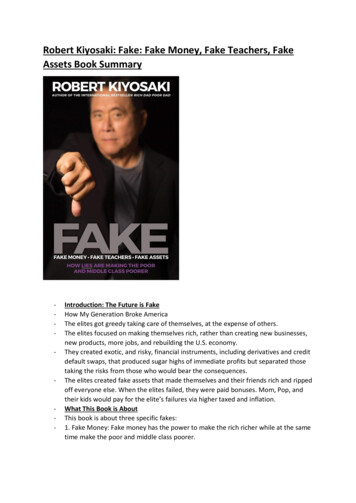
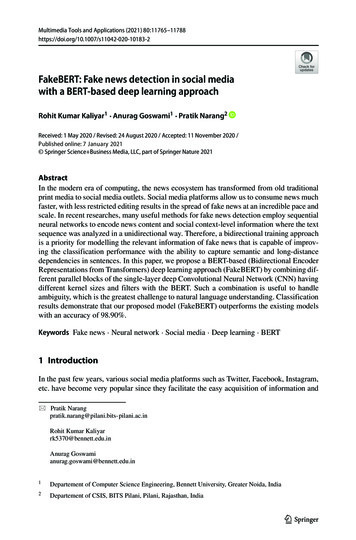
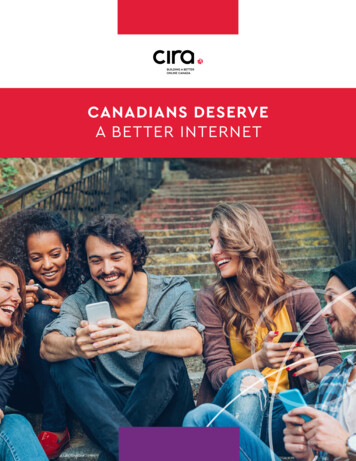

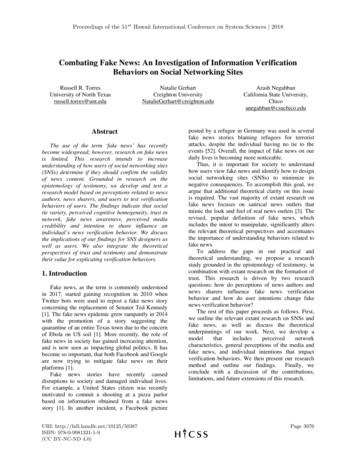
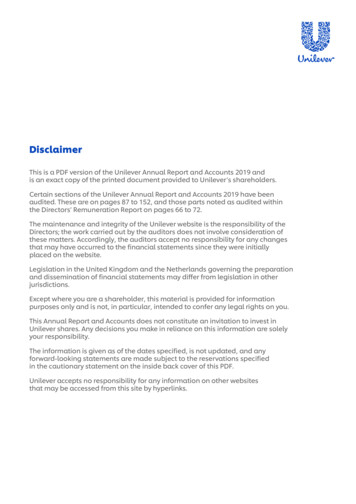
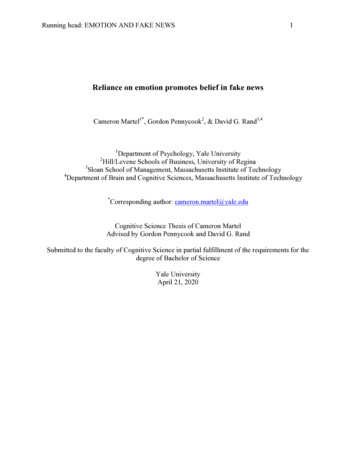
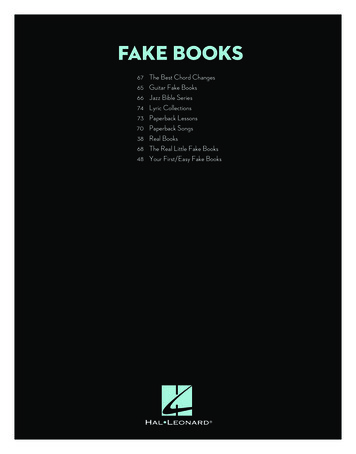

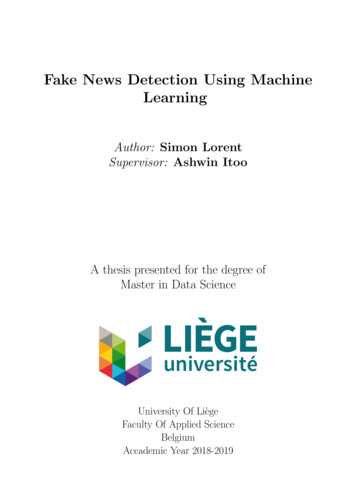
![Fake Notepad Crack Free X64 [Latest 2022]](/img/41/fake-notepad-crack-free-download-x64-latest-2022.jpg)